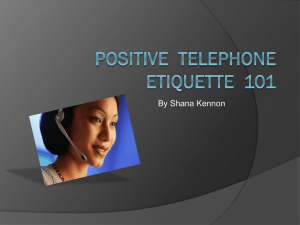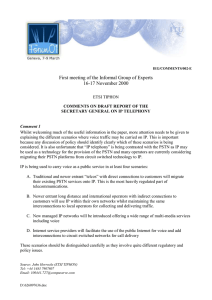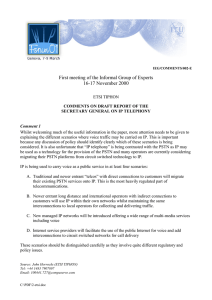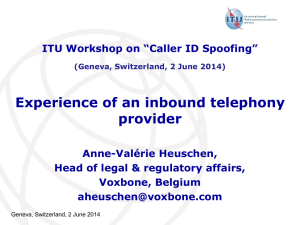ITU WORKSHOP ON ‘ORIGIN IDENTIFICATION AND ALTERNATIVE CALLING PROCEDURES’:
advertisement
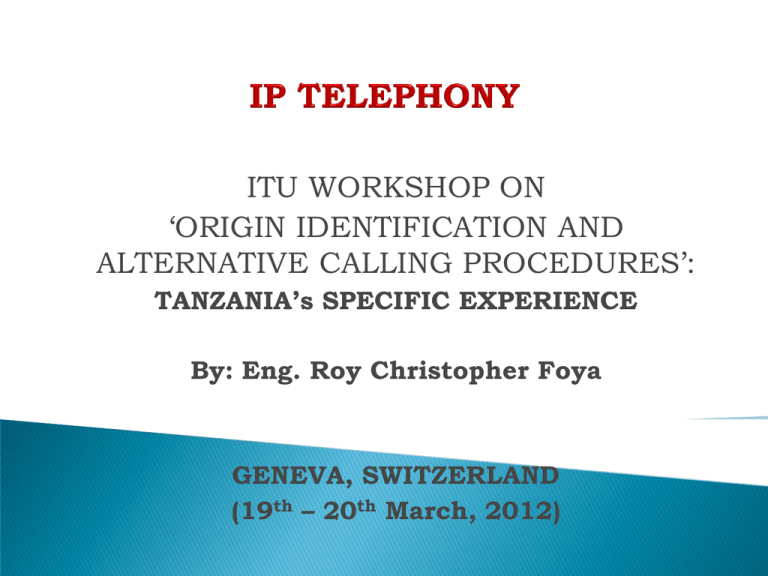
ITU WORKSHOP ON ‘ORIGIN IDENTIFICATION AND ALTERNATIVE CALLING PROCEDURES’: TANZANIA’s SPECIFIC EXPERIENCE By: Eng. Roy Christopher Foya GENEVA, SWITZERLAND (19th – 20th March, 2012) Internet around TANZANIA IP Telephony: Four stages of evolution Country case –KEY ISSUES Infrastructure readiness Concluding Remarks Tanzania has been accessing Internet via satellite capacity until late 2006 when the submarine cables started to come alive Recent survey indicated that there are over 1475 Mbps satellite capacity (Uplink + Downlink) and over 1984 Mbps capacity on submarine cable Substantial efforts has been put already to construct and interconnect Tanzania with Neighboring countries via optical fiber cable • PC-to-PC (since 1998) Connects multimedia PC users, simultaneously online PC-to-Phone (since 1999) PC users make domestic and international calls via gateway Increasingly services are "free” (e.g., Dialpad.com) Phone-to-Phone (since 2000) Voice/Web integration (since 2001) Calls to website/call centers and free phone numbers Enhanced voice services (e.g., integrated messaging) Technical: Service definition: It has been noted that operators have been using the term ‘VOIP’ and ‘IP TELEPHONY’ interchangeably. While the ISPs with IP based networks prefer the term VOIP , the Voice service providers prefer the term IP TELEPHONY to extend the service to the market audience. However in both scenarios ON-NET calls has been treated as an added value service as it attracts relatively low cost as opposed to OFF-NET calls Technical ….. Compromise in quality of service: Initially there were number of quality of service issues such as bandwidth limitation on satellite, teething problems in setting up the solution, unapplied compression techniques, etc. This has now been addressed by the arrival and substantial effort in landing the submarine cables and the inter-country fiber network through the National ICT backbone project Interconnection between IP-Based networks and PSTN: While the IP based networks are characterized by their ability to hold and process higher levels of traffic volume, the circuit switched networks had some bottleneck in this. So there were issues in interfacing the two networks and capabilities. With the arrival of NGN and IN platforms to most of the operators this is technically been addressed. Economic: What price and cost savings is expected by the clients or consumers? Consumers expect IP telephony to hugely cut down communication cost; but ……..How quickly can all carriers migrate their networks? Regulatory: •Licensing : The Regulator grants operating licenses and assigns the numbers to providers to operate this service •Resource allocation : Numbering is managed by the regulator Emergency services Calling Line Identification (CLI) Implementation of emergency service numbers and CLI are demonstrated in the following slide Number portability (NP): Regulations were published in December 2011 (http://www.tcra.go.tz/regulation/numberPortability.pdf) and the implementation of mobile NP is planned to be implemented in 2013 Emergency call origination: An emergency call from an IP network(caller 2 &3 ) will require that the provider has a routed network to the destination (emergency call centre). Currently, a call will be taken to the provider network who will process it either direct to the called destination or through other network providers to whom they are inter-connected . Since most ISP (IP network providers ) have no direct connection to the emergency call receivers, this is implement by routing the call to PSTN and other Mobile network provider. Alternative the IP network provider may connect direct lines (Caller 1) to her network and call manager/router will route the emergency call through this number. Calling Line Identification (CLI): ISPs are supposed to allow a customer of their network to be able to make a call from anywhere as long as he/she has internet connection. We can only achieve CLI from caller 2 & 3 by capturing the IDs during authentication of the caller to the network. This does only provide the name of the customer or organization for which the number has been given. The challenge here is that it is tricky to make an identification to a level of an individual caller Continuing effort in building Advanced infrastructure, especially excellent broadband access in Tanzania built using WIMAX, FIBER and NGN networks are at a far much better stage for now Telecommunication Industry ready to invest in innovative opportunities and applications such as interactive SMS, online banking, medical activities, e-Life including retrieving personal data, etc. Further engagement in ITU Study Group 2 activities in order to: update and up keep countries like Tanzania in the migration of its legacy voice service to IP based networks; Continue looking for Identification and Future Numbering Solutions THANK YOU! Roy.foya@africaonline.co.tz

